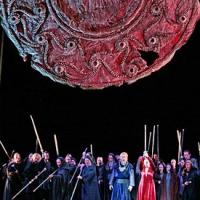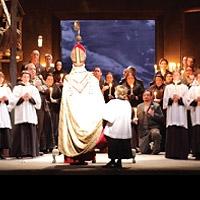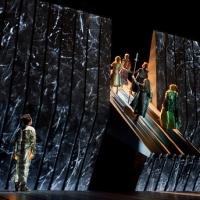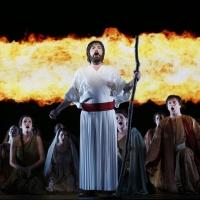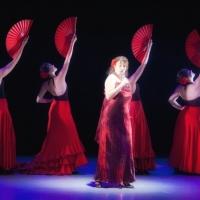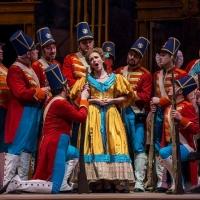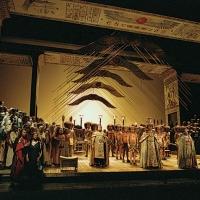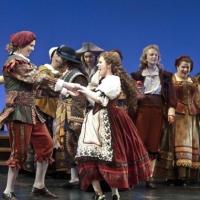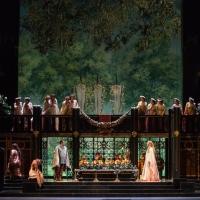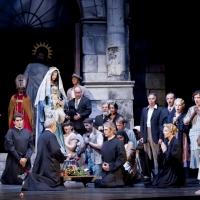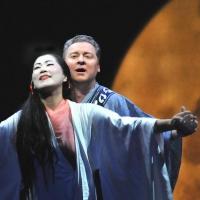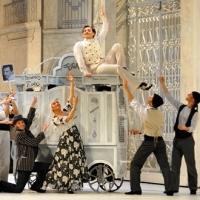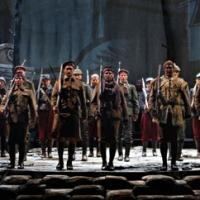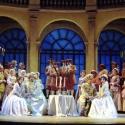Scott Frost
 Scott Frost is a Production and Stage Manager and a Freelance Costume Designer. In addition to being a theatrical manager and designer he currently works for Music Theatre International, the leader in the theatrical licensing industry, specializing in Broadway, Off-Broadway and West End musicals.
Scott Frost is a Production and Stage Manager and a Freelance Costume Designer. In addition to being a theatrical manager and designer he currently works for Music Theatre International, the leader in the theatrical licensing industry, specializing in Broadway, Off-Broadway and West End musicals.
MOST POPULAR ARTICLES
October 28, 2013
It's not everyday that you watch the interconnectivity of two separate people communicating via Internet chat room. Let alone, how about five people's conversations over several weeks with an entire chorus of “chaters” behind them. It adds up to quite the stack of transcripts. The idea, while seeming passé, remains a relevant topic to discuss and bring forward on the Met's stage. The usually very formal performance space was filled with internet lingo such as PWOS, A/S/L, LOL, WTF, and any abbreviationyou could think of. Nico Muhly's “Two Boys” is a new and innovative work that has extremely dark overtones both in the production as well as the musical aspects of the piece. “Two Boys,” with a libretto by Craig Lucas tells the story of a 16-year-old boy who is convinced by unknown people he has met through Internet chat rooms to attempt murder on his 13-year-old 'friend'.
October 7, 2013
Bellini's “Norma” opened at the Metropolitan Opera last Monday night to a full audience giving resounding praise to the leading lady, soprano Sondra Radvanovsky. Ms. Radvanovsky's performance of the title role was incredibly expressive and most articulately nuanced. Her inaugural American performance of the role was the driving force that kept John Copley's otherwise dull production moving forward. Having been the first time she has sung bel canto at this house, she performed with amazing elegance, drawing the audience to her voice with seductive pianissimos and trumpeting top notes.
May 2, 2013
Los Angeles Opera has been a tour de force since its inaugural production of Verdi's Otello starring Placido Domingo in October 1986. Both Founding General Director Peter Hemminds and subsequently after Placido Domingo the company has grown in 25 short years to be the United States' fourth largest opera company. The LA Opera is known for embracing the spirit and artistic nature of Los Angeles in producing world-class opera that preserves, promotes and advances the art of opera for the greater public.
April 25, 2013
The first of three complete Ring Cycles concluded on Tuesday night at the Metropolitan Opera as our hero, Siegfried, his true love, Brunnhilde, as well as the entirety of Valhalla went up in a burst of video projected and staged lit flames behind the massive 45-ton set of 24 rotating planks come to be known by some as Robert Lepage's Ring machine. Luckily for everyone involved- audience, performers and technicians alike, this cycle ran quite smoothly in comparison to previous seasons. One mishap happened in Das Rheingold as we descended into Nibelheim and the last five or six planks got stuck in the air and one black clad arm was seen pulling each back into place. Barring this one blip in an otherwise 19 hour breathtaking production is rather impressive given the scale and scope of this production which includes hydraulics, harnesses, flying, dying, fighting, love making, and a host of technical demands all enhancing the complex masterpiece which is Richard Wagner's music and libretto.
April 25, 2013
Opera Idaho was founded in 1973 though the existence of opera in Boise dates back much earlier. Since the early 1960's, the Boise Philharmonic has been producing annual operas featuring singers from the surrounding region. When these were discontinued in the late 60's, Mrs. Hazel Weston and a large group of local opera enthusiasts formed the Boise Opera Workshop. The early company provided workshop productions, monthly public lecture programs and group studies of operatic works. In the continued efforts to producing grand opera, the company changed its name in 1973 to Boise Civic Opera and by 1977 they were already importing professional singers to perform the principal roles in its productions. In 1983, the company changed its name again, to Boise Opera, to recognize the increasing professionalism of the company's productions.
April 15, 2013
Since moving out of the Lincoln Center two years ago, the New York City Opera has taken to playing its productions at a number of venues throughout the city, including the Brooklyn Academy of Music, but Sunday marked a homecoming for the company. New York City Opera continued its season with a new production of Rossini's Moses in Egypt at its birthplace, the New York City Center. In addition to this exciting homecoming, this production is the operas first full production in NYC in well over a century. This combination mixed with newly appointed music director Jayce Ogren at the podium of this innovative production proves to be a thrill from the restoration of light through the separating of the Red Sea.
April 11, 2013
Mississippi Opera, once known as the Jackson Opera Guild was started in 1945 mainly by the efforts for Mignonne Caldwell, the wife of John Caldwell. Her hard work with the support of an ever growing number of vocal and instrumental performers in the Jackson area created what was at the time one of only twelve organization in the entire United States. The group was officially incorporated in 1947 in hopes to promote and encourage the study and appreciation of Opera as an art form while developing operatic talent and performance.
April 4, 2013
PORTopera has quite an interesting inception story, dating back to the 1970s when Bruce Hangen, at that time Music Director for the Portland Symphony dreamed of forming an opera company in Maine. In 1985, Hangen accepted the Music Director position for the Omaha Symphony in Nebraska. This did not end his dreams of creating a summer season back in Maine and finally in 1994 the Portland State Theater became available. The time had come for Hangen and a group of friends and supporters created the company, then known as Portland Opera Repertory Theatre. The first production of the company was in July 1995 at the State Theater with Bizet's 'Carmen.' The overwhelming response led to another summer season in '96 with Puccini's 'Madama Butterfly.' In the second season the company also introduced PORTopera's Young Artists Program to help the careers of emerging young singers.
March 28, 2013
Since its premiere in 1859, Faust has been a moderate success in comparison to its counterpart, Goethe's epic drama of the same name, and the Mets current revival of the 2011 production holds true. This production, directed by Tony Award winner Des McAnuff does well to add interest where the original opera falls short. Looking at the opera for its musicality, the production is spot on; for its modernized atomic design complete with beautiful projections that fill the Met stage, the production is again spot on; though somehow when combined with the five act score, expertly conducted by Alain Altinoglu, the night at the opera tends to be remembered as again just a moderate success.
March 28, 2013
The first recorded opera performance in Tulsa dates back to 1904 with a production of Faust- just six years after the city was incorporated. Forty-four years later, in 1948, an official company was started, known today as Tulsa Opera. In the early years the Company presented opera and operettas twice yearly with only one or two paid professional singers but quickly it became evident that this was not enough. The company continued to grow with every season and is now the 18th oldest opera company in North America and has continued to grow and gain support over the years. Tulsa opera is now ranked among the ten favorite regional opera companies in the United States. The company now presents three grand opera each season and draws audiences from a five state region that includes Oklahoma, Arkansas, Kansas, Missouri and Texas.
March 21, 2013
Seattle Opera has been one of the leading American opera companies since being founded in 1963. Presenting a mixture of European classics as well as new works of American opera, the company's five opera seasons continually advance the cultural life of the Pacific Northwest through education and performance. Seattle Opera strives to produce musically extraordinary, theatrically compelling operas by employing the highest quality casts, conductors, directors and designers. They have been so successful in this that they actually have the highest per capita attendance of any major opera company in the U.S. In addition to their mainstage productions however, the Company serves thousands more through its groundbreaking education programs, scenic rental program and other special projects.
March 14, 2013
The Atlanta Opera has continued to be a leading regional opera company since it was founded in 1979. The company produces mainstage opera productions as well as several arts education programs for all ages. Each season the Atlanta Opera strives to expand the experience of its patrons with memorable and exciting performances while providing the best musical and theatrical quality while also supporting the community and educational programs. Thusly, the Opera annually employs the finest in international, national and regional singers, conductors, stage directors and designers.
March 8, 2013
We all sat waiting anxiously for the curtain to rise on Riccardo Zandonai's 'Francesca da Rimini' after almost a 27 year hiatus on the Met stage; but with each passing act, one could sense the audience waiting for the closing curtain just as intently. Not to say that the performances or design weren't a wonder to behold. The opera and production as a whole just seemed a bit trivial in comparison. Despite the story however, the musical prowess of Zandonai's score, the meticulously detailed sets, and exquisite costuming gave Monday nights opening of 'Francesca da Rimini' redeeming beauty amid a insipid story.
March 7, 2013
Arizona Opera was originally known as Tucson Opera Company and founded in 1971 by a group of opera enthusiasts. The inaugural season was two performances of The Barber of Seville by Rossini in Tucson but by the 1976-77 season the company was performing their complete seasons in both Tucson and Phoenix. Now in the 42nd season, the company produces five grand operas throughout the state each season and is one of the only companies in the US that performs in two cities.
February 28, 2013
Boston Lyric Opera (BLO) was founded in 1976 and has risen to be New England's largest opera company. Each season the company produces three mainstage productions at the companies home, the Citi Performing Arts Center Shubert Theatre, in Boston and a the annual Opera Annex production in a found space. throughout New England. This season fulfills he mission of BLO which is to produce artistically excellent productions of a diverse repertoire that entertain and inspire audiences while featuring emerging operatic talent in order to engage and educate the community of all ages.
February 26, 2013
New York City Opera's production of Britten's chamber opera 'The Turn of the Screw' opened Sunday afternoon to a full house at Brooklyn Academy of Music's Howard Gilman Opera House as the Prologue, played by Dominic Armstrong, fills us in on the back story as it is played out onstage. The stark setting with desk and chair and overhead fluorescent lighting sets the mood to which the score builds upon throughout the prologue. We watch the Governess in an interview with a man to care for two orphaned children who we find out to be his niece and nephew. After accepting the position to help 'such a busy man', we eerily follow the Governess, played by Sara Jakubiak, down the country road to her new life. The scene is now set for Act I of this production which director, Sam Buntrock, describes as having been drawn 'from iconic films such as The Shining, The Exorcist and Poltergeist.
February 21, 2013
The Hawaii Opera Theatre (HOT) has a rich history dating back to 1960 when it opened with Madama Butterfly with performances in McKinley High School Auditorium. The company has continued to evolve into what it is today- with international artists who have graced the most renowned stages as the New York Metropolitan Opera, La Scala, the Royal Opera house and many others through Europe, Asia and North America.
February 14, 2013
The San Francisco Opera celebrates its 90th year since it was founded by Gaetano Merola in 1923. Currently the second largest opera company in North America, the San Francisco Opera has grown from one production presented for two weeks to 75 performances of ten different operas running from September to July.
February 7, 2013
Minnesota Opera stems all the way back to 1963 when The Masque of Angelsby Dominick Argento was commissioned by the Walker Art Center for its performing arts program, Center Opera. The group continued to grow until it became its own entity in 1969 and changed the name in 1971 to the Minnesota Opera. The company quickly became known as an 'alternative opera company' to complement the traditional Metropolitan Opera tour that came through each year and the St. Paul Opera Company but in 1975 Minnesota Opera and St. Paul Opera merged and set their focus on both traditional repertory and contemporary opera.
January 31, 2013
Sarasota Opera has a long history of bringing opera to the people along the Gulf Coast. Starting in 1960 when the group was called Asolo Opera Guild the company presented a touring chamber-sized company, Turnau Opera's productions in the 320 seat Asolo Theater at the Sarasota Ringling Museum of Art. Starting in 1973 the company began producing their own productions when they recognized the need for a theater more conducive to opera. The company bought the former A.B. Edwards Theater and began renovations in 1982. In 1984 the company, now being called Sarasota Opera, opened the Sarasota Opera House which is now on the National Register of Historic Places.
Videos



